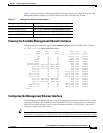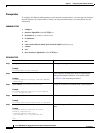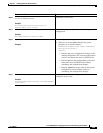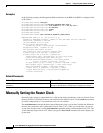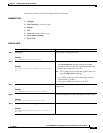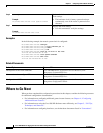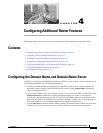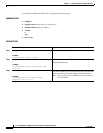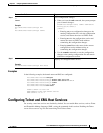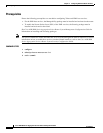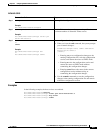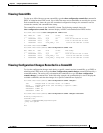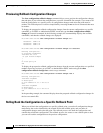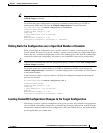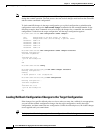
4-3
Cisco ASR 9000 Series Aggregation Services Router Getting Started Guide
OL-17502-01
Chapter 4 Configuring Additional Router Features
Configuring Telnet and XML Host Services
Examples
In the following example, the domain name and DNS are configured:
RP/0/RSP0/CPU0:router# configure
RP/0/RSP0/CPU0:router(config)# domain name cisco.com
RP/0/RSP0/CPU0:router(config)# domain name-server 10.1.1.1
RP/0/RSP0/CPU0:router(config)# commit
RP/0/RSP0/CPU0:router(config)# end
RP/0/RSP0/CPU0:router# show hosts
Default domain is cisco.com
Name/address lookup uses domain service
Name servers: 10.1.1.1
Configuring Telnet and XML Host Services
For security, some host services are disabled by default. You can enable Host services, such as Telnet
and Extensible Markup Language (XML), using the commands in this section. Enabling the Telnet
server allows users to log in to the router using IPv4 Telnet clients.
Step 4
end
or
commit
Example:
RP/0/RSP0/CPU0:router(config)# end
or
RP/0/RSP0/CPU0:router(config)# commit
Saves configuration changes.
• When you issue the end command, the system prompts
you to commit changes:
Uncommitted changes found, commit them before
exiting(yes/no/cancel)?
[cancel]:
–
Entering yes saves configuration changes to the
running configuration file, exits the configuration
session, and returns the router to EXEC mode.
–
Entering no exits the configuration session and
returns the router to EXEC mode without
committing the configuration changes.
–
Entering cancel leaves the router in the current
configuration session without exiting or
committing the configuration changes.
• Use the commit command to save the configuration
changes to the running configuration file and remain
within the configuration session.
Step 5
show hosts
Example:
RP/0/RSP0/CPU0:router(config)# show hosts
Displays all configured name servers.
Command or Action Purpose



